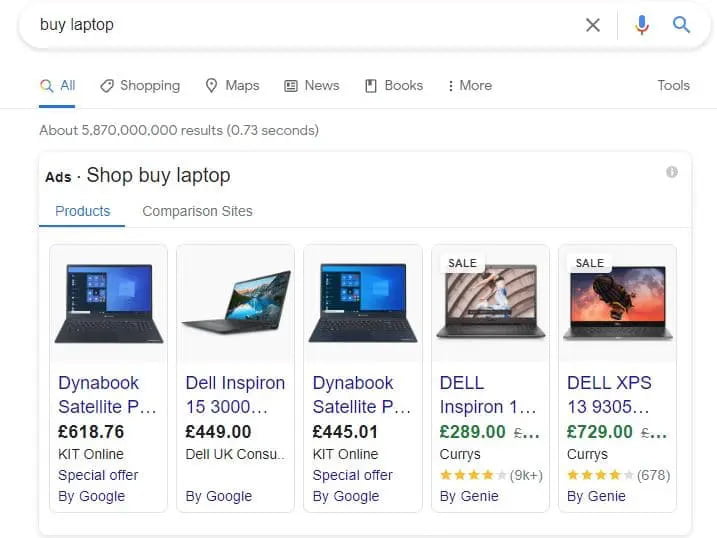
Free Digital Marketing Review
We’ll show you how to hit your business goals with result-driven digital marketing.
In modern SEO, trying to rank for keywords without considering the searcher’s intent is a big mistake.
Search intent matters for PPC too, as you need to tailor your ad and landing page to the searcher’s needs.
But what exactly do we mean by intent? Well, it’s what sort of action the searcher is looking to take. Are they looking to learn, buy or find something?
Keywords often give a clue as to what searchers want, and Google has become very good at aligning the results to intent.
Because of this, it’s become vital to match your keywords to your content. You don’t stand a chance of ranking a product page for a ‘how to…?’ query, or a blog post for a ‘buy…’ search.
Read on for a guide to the four types of search intent and how you can target them.
Informational
Informational intent, as the name suggests, is when searchers are looking for information.
But what does this look like? It can be questions – often beginning with phrases such as ‘how to’ and ‘why’ – or can be more generic terms.
Very broad, unbranded terms such as ‘London’ or ‘social media’ will often be interpreted by search engines as having informational intent, and the first page results will consist of pages such as Wikipedia, blogs and ‘People Also Ask’ boxes.

Target informational intent queries with blog posts that explain topics in your industry (like this post!) or answer common questions.
Something to bear in mind when it comes to informational keywords: if Google thinks the searcher is after specific information – such as a definition or an answer to a question – the search results page may have what’s known as a ‘featured snippet’:

Featured snippets extract information from webpages that Google thinks will help quickly answer searchers’ queries. The featured snippet can be taken from any relevant web page but is usually (though not always!) taken from something already on the first page of the search results.
It can be a huge SEO boost, as you are effectively jumping to the top of the first page and encouraging searchers to click through by giving them a preview of your useful content.
Navigational
Navigational intent is when the searcher is trying to find a specific site through a search engine rather than using the web address to go straight there.
This isn’t just your grandma googling ‘Google’ – it’s actually a very common search intent when people are either feeling lazy or are unsure of a site’s full URL so can’t go there directly.
You definitely want your site to come at the top of the results when people google your business name, but this isn’t always as easy as it seems.
If your URL doesn’t match your business name, and your page is not otherwise optimised with your business name as a target keyword, you may find yourself further down the search results. This is particularly likely if your business has a similar name to other businesses.
Your site being hard for navigational searchers to find could cause you to miss out on valuable leads who are actively interested in your business (they are searching your name, after all!).
So, it’s important to take navigational intent into account when choosing your keywords. Though most small businesses may lack brand recognition and so should mostly focus on more general keywords rather than just their business name, it’s still important that anyone looking for you directly can find you easily.
Please don’t take it as a given that you will rank for your business name without any keyword planning!
Try to feature your business name as a target keyword on your homepage to ensure your site ranks when people search for you.
Transactional
Transactional intent means the searcher is actively looking to buy a product or service.
These are keyword phrases including words such as ‘for sale’ or ‘buy’.
Transactional intent keywords are of course highly valuable to businesses, as they suggest the searcher is ready to buy immediately.
Ideally, you want your product or order page to appear for these types of searches, to save the searcher from having to click around your site to make their purchase.
Transactional intent usually means the searcher wants to buy as soon as possible, so they may not appreciate a blog post appearing when they are trying to make a purchase.
These keywords can sometimes be a little awkward to target organically due to the slightly unnatural phrasing of transactional phrases. It can be difficult to incorporate something like ‘buy headphones’ into a product description without sounding spammy.
Though it’s worth organically optimising for transactional keywords where possible, it’s a bit easier to target transactional keywords with paid search ads that direct the searcher to a product page.
These keywords can be competitive to bid on but usually have a high conversion rate.
It’s also a good idea to have Google Shopping ads enabled if searchers in your niche use a lot of transactional keywords, as Shopping ads are often triggered to appear in the search results by keywords including terms like ‘buy’.

Commercial
Commercial intent is when a searcher isn’t quite looking to buy but is researching a product.
These are keywords including terms like ‘best’, ‘top’, ‘review’ or ‘vs’.
Commercial searchers are curious about a product but want to read up on it before deciding to purchase, and possibly want to compare a few different options.
Commercial intent keywords tend to bring up listicles, reviews and articles comparing the specs of similar products.
Target these keywords with relevant blog posts rather than product pages (searchers are looking to research – not buy just yet!). For example, a ‘Best 10 Products’ style listicle.
It can seem difficult to write this type of post in a way that promotes your product without promoting your competitors’, but the trick is to expand the focus of the list beyond your specific product.
For example, if you sell curtains, you could write an article about interior design in general: ‘Top 10 Home Furnishings to Refresh Your Living Room This Season’.
This way you can mention your curtains but fill the rest of the list with complimentary products from non-competitors.
Conclusion
Search intent is a crucial step of both SEO and PPC that many people overlook.
Figuring out exactly what searchers are looking for will help you to align your content to intent. Why waste a great keyword on an irrelevant page or ad?
Most searches fall into one of the above intents, so use them to determine where your chosen keywords fit best on your site or within your paid campaigns. This small addition to your keyword strategy should give your rankings and clickthrough rates a major boost!
We hope this guide to keyword intent was useful. If you need a little more advice on keywords or digital marketing in general, get in touch and we’ll see what we can do!

Need help with your website and marketing?
Book a FREE growth strategy session with our experts
Our award-winning team will review your website and marketing goals to provide you with crucial insight and advice.

4.9 STAR
Google reviews
With 10+ years of experience, Link Digital has helped hundreds of businesses to succeed online. We can help yours too!

